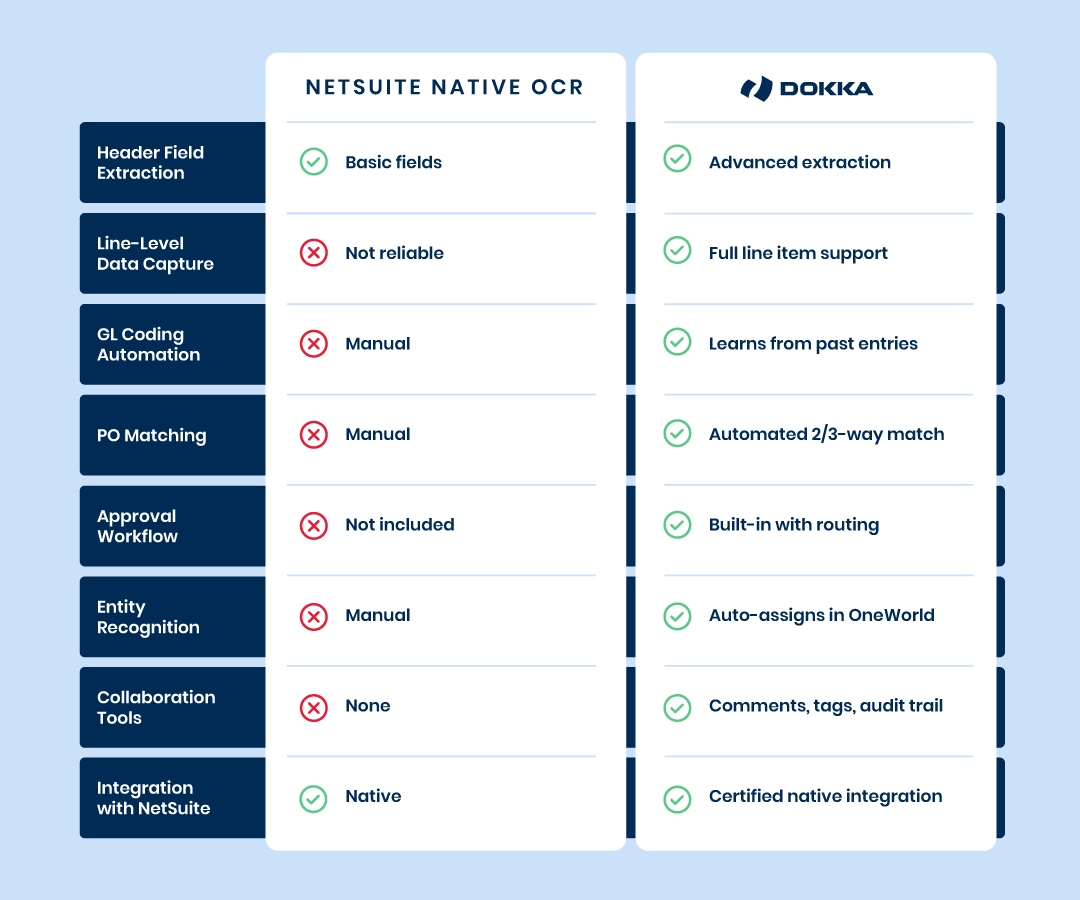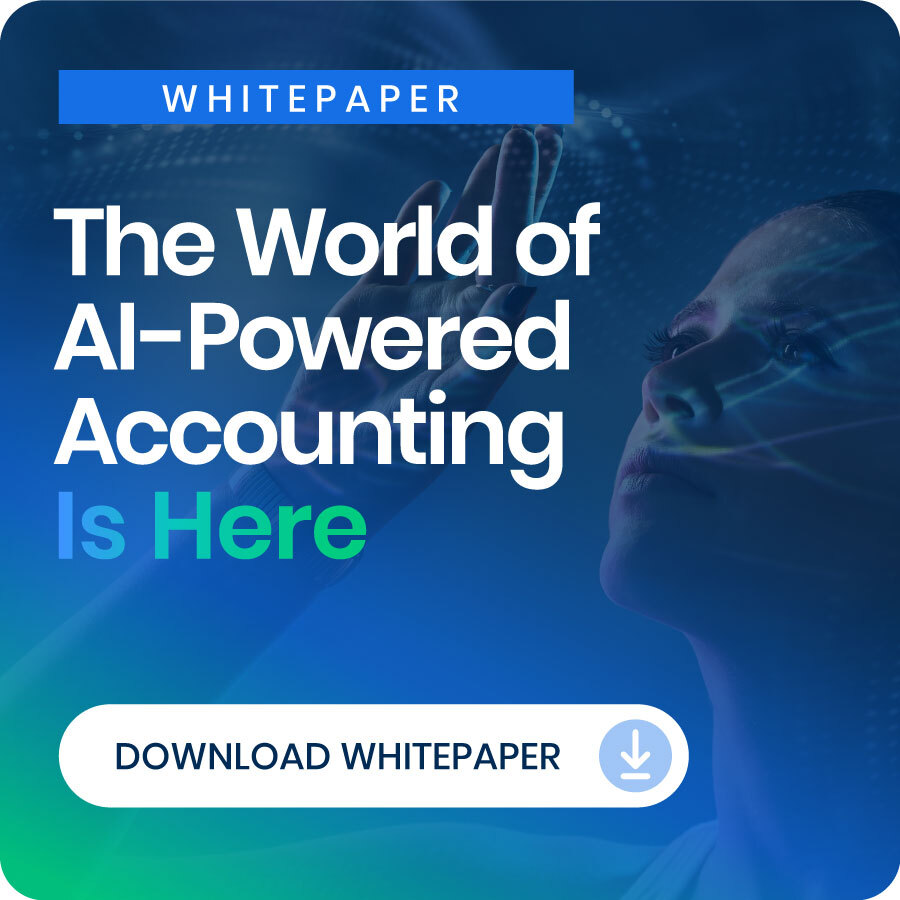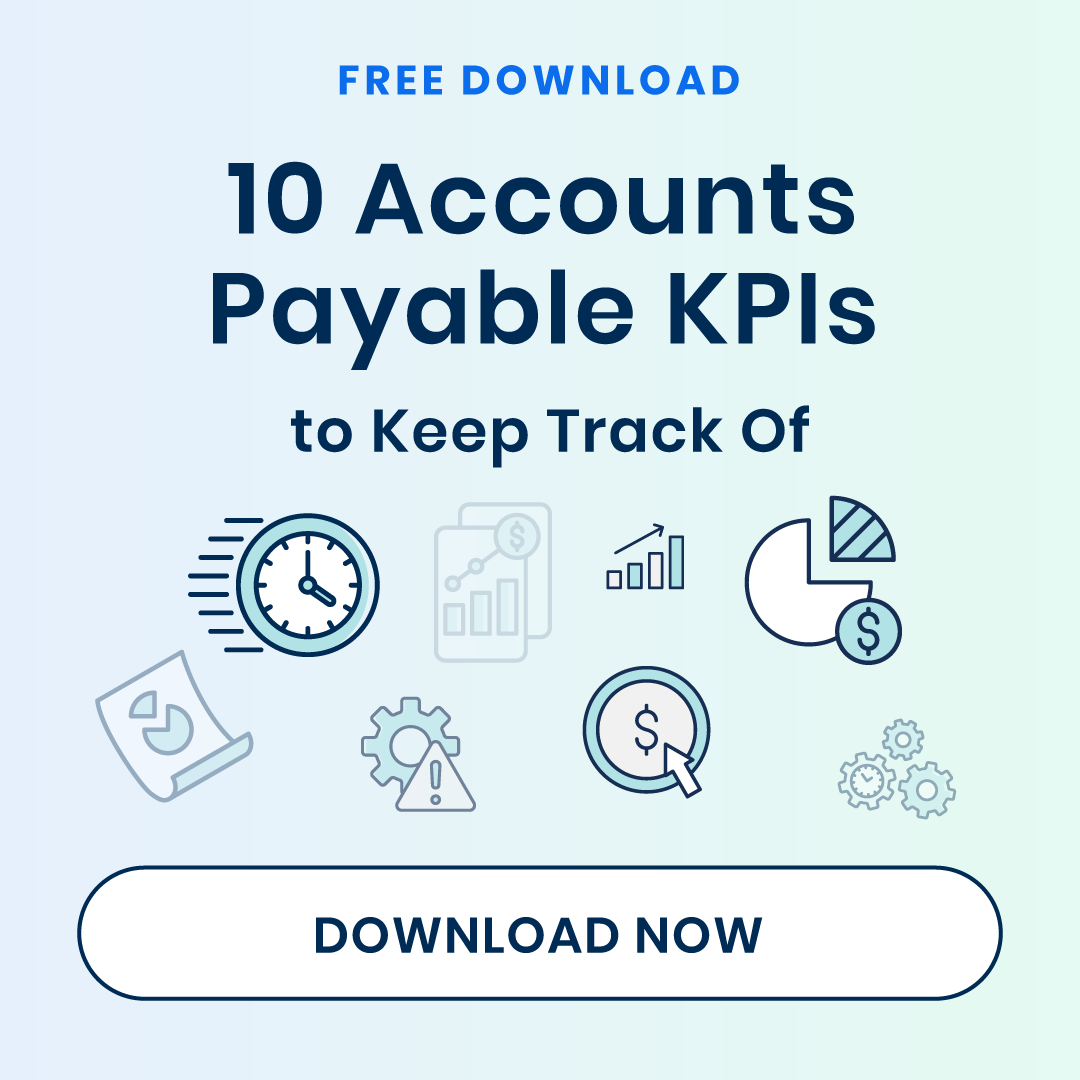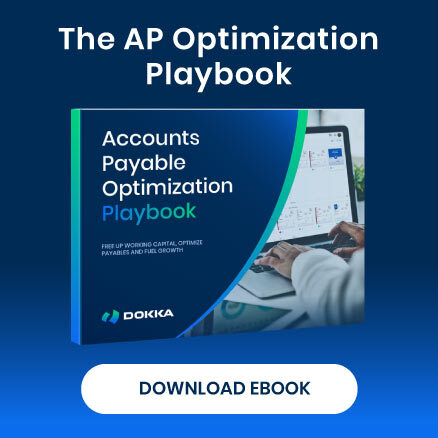When it comes to automating accounts payable, OCR (Optical Character Recognition) offers the promise of fast invoice scanning, reduced manual work, and real-time AP processing.
Users looking to automate invoice handling often ask, “Doesn’t NetSuite already have built-in OCR? Why would I need anything else?”
It’s a valid question, and one we frequently hear from finance and AP teams exploring automation.
If you’re a NetSuite user, chances are you’ve encountered DOKKA’s NetSuite AP automation module as well as NetSuite’s own native OCR functionality—part of its AP automation offering—either during implementation or while searching for ways to reduce invoice entry workloads.
NetSuite’s OCR can help lay the groundwork for automation, but there are important limitations to consider, especially if the goal is a truly hands-free, end-to-end invoice automation workflow.
In this article, we’ll break down what NetSuite’s native OCR can do, where it falls short for AP teams, and when (and why) third-party automation tools like DOKKA become a smart addition.
![]()
What Is OCR in the Context of Invoice Automation?
OCR is a technology that reads characters from scanned or digital documents (such as PDFs) and converts them into structured text data usable in systems like NetSuite.
In accounts payable, OCR is commonly used to read invoices and extract key fields, including:
- Vendor name
- Invoice number
- Date
- Line items
- Amounts
- Payment terms
Once extracted, the data is entered into your ERP or accounting platform—eliminating the need to retype it manually.
![]()
What NetSuite’s Native OCR Does Well
NetSuite’s OCR functionality is part of its AP Automation module and is designed for customers seeking a basic, integrated OCR experience.
For teams beginning the transition away from manual data entry, it offers meaningful value:
1) Basic Field Recognition from PDF Invoices
When an invoice is received via email through the vendor bill capture feature, NetSuite’s OCR engine can extract key header fields such as vendor name (if recognized), invoice number and date, amount, due date. These fields are automatically populated into a draft vendor bill, giving AP teams a head start.
2) Seamless Integration Into the NetSuite UI
As a native feature, there’s no need to switch systems or rely on middleware. OCR results appear directly within NetSuite’s Vendor Bill entry screen, aligning with existing workflows and allowing finance teams to validate or edit data before posting.
3) Vendor Record Matching (in some cases)
NetSuite attempts to match the invoice’s vendor to an existing vendor record using cues such as email domain or invoice content. When successful, this reduces the need for manual vendor identification.
4) Email-to-Invoice Functionality
Vendors can send invoices to a designated email address, where NetSuite captures the attachment, applies OCR, and creates a draft bill. This streamlined entry point eliminates the need for manual file uploads.
![]()
Where NetSuite’s Native OCR Falls Short and How DOKKA Fixes It
While NetSuite’s OCR provides a basic entry point to automation, it lacks the flexibility and intelligence needed by high-volume, multi-entity, multi-currency accounting operations.
There’s a lot to unpack, so here’s a breakdown of what NetSuite OCR can’t do (or doesn’t do well)—and how tools like DOKKA step in to fill the gaps.
![]()
1) Limited Line-Level Data Capture
A frequent complaint among NetSuite users is that the native OCR tool doesn’t reliably extract line-level details from invoices.
If your AP team requires:
- Descriptions, quantities, and unit prices
- Tax breakdowns
- Item codes or SKU mapping
- GL account allocations per line
…NetSuite’s native OCR won’t meet those needs. That data often has to be entered manually (or copied and pasted from the invoice), leaving the most time-consuming part of invoice entry on your team’s shoulders.
DOKKA, on the other hand, captures full line-level data, including item descriptions, quantities, units, and tax lines, and automatically maps them to the correct fields in NetSuite.
![]()
2) No Intelligent GL Coding or Learning Capabilities
NetSuite’s OCR extracts data but does not learn from historical transactions.
That means:
- GL accounts must be applied manually
- Coding remains inconsistent unless users are highly meticulous
- No automation exists for defaulting expense categories based on vendor or PO
DOKKA leverages AI and historical data to auto-suggest GL accounts based on how similar invoices were previously coded—improving accuracy and reducing rework.
![]()
3) Weak PO Matching and 3-Way Match Automation
For companies using purchase orders, NetSuite’s OCR does not automatically match invoice line items to POs or receipts. Manual reconciliation of quantities and prices is still required.
The process becomes especially frustrating for teams relying on 2-way or 3-way match to validate vendor bills.
DOKKA automates PO matching, flags mismatches, and enables users to resolve exceptions within the same interface (before posting to NetSuite).
![]()
4) Minimal Support for Complex or Multi-Entity Environments
Companies using NetSuite OneWorld or managing multiple subsidiaries often encounter issues with the OCR engine, which lacks the ability to intelligently assign invoices to the correct entity.
Common problems include:
- Mismatches
- Incorrect subsidiary assignment
- Manual corrections later in the workflow
DOKKA identifies entities using vendor, email source, or document content, and routes each invoice to the appropriate destination from the start.
![]()
5) No Built-In Approval Workflow
NetSuite supports approval routing for vendor bills, however, the OCR process lacks a built-in approval checkpoint before the bill reaches your books.
Finance teams often require a structured flow in which invoices are:
- Extracted
- Reviewed
- Routed to the appropriate stakeholder
- Approved
- Then posted to the ERP
DOKKA offers a complete, finance-focused approval workflow that includes comments, tags, delegation, and audit logs.
![]()
6) No Collaboration or Exception Handling Features
When an invoice is flagged or unclear, NetSuite’s native OCR lacks built-in collaboration tools for clarification or escalation.
In practice, this leads to:
- AP teams chasing down answers via email or Slack
- No clear record of who handled what
- Exception handling becoming a disconnected side process
DOKKA solves this by centralizing all collaboration within the invoice interface. Questions, approvals, comments, and resolutions are all captured in one place, directly tied to the transaction.
![]()

![]()
Why OCR Alone Isn’t Enough for Modern AP Automation
OCR is just one piece of the automation puzzle.
Modern finance teams need more than partial OCR assistance, they’re seeking true end-to-end invoice automation. That includes:
- Invoice capture from any source
- Accurate, full-field data extraction
- Smart GL coding
- Approval workflows
- PO matching
- Real-time posting to NetSuite
- Auditability and exception tracking
OCR alone can’t meet all these needs. DOKKA combines OCR with AI, NetSuite-specific logic, and collaboration tools—providing a full-stack solution for invoice automation.
![]()
Common Questions About NetSuite OCR
![]()
Can NetSuite OCR process invoices from multiple vendors with different formats?
Yes, but with limited consistency. Complex or irregular formats can confuse the parser.
DOKKA handles vendor-specific variations without requiring templates or manual setup.
![]()
What happens if NetSuite’s OCR fails to recognize a field?
Manual correction is required in the draft bill.
DOKKA highlights low-confidence fields for review, allowing users to easily fix issues before posting.
![]()
Does NetSuite OCR support scanned paper invoices?
Yes, if converted to PDF—but performance depends on scan quality.
DOKKA is optimized for both scanned and digital invoices, offering stronger OCR reliability.
![]()
Can NetSuite’s OCR engine be trained over time?
Not in a meaningful way. It lacks built-in learning capabilities.
DOKKA’s AI learns from user corrections and improves its accuracy invoice by invoice.
![]()
Can NetSuite OCR auto-code expenses to GL accounts?
No, coding must be done manually.
DOKKA auto-suggests GL codes based on past behavior, vendor, and invoice content.
![]()
Ready to Go Beyond Basic OCR?
Book a demo to see how DOKKA can enhance your NetSuite AP automation with smart invoice capture, line-level data entry, and true end-to-end workflows—no templates or typing required.
![]()




